When (Neutron) Stars Collide Via NASA Http://ift.tt/2hK4fP8

When (Neutron) Stars Collide via NASA http://ift.tt/2hK4fP8
More Posts from Xyhor-astronomy and Others

Remnant of supernova toward the constellation of Vela, which exploded 11,000 years ago.
Image credit: NASA / Chandra x-ray Observatory
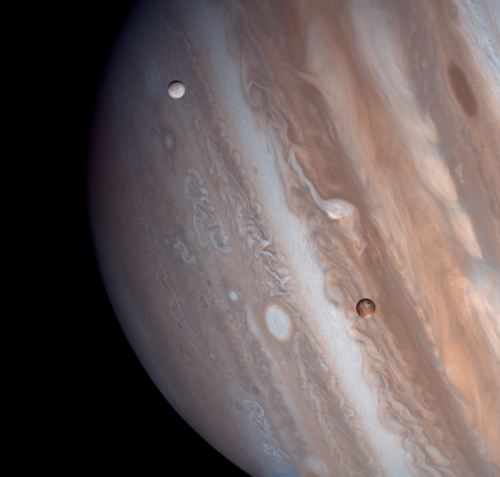
Io and Europa taken by the Voyager 1 spacecraft in 1979
Image credit: Justin Cowart
![Andromeda [x]](https://64.media.tumblr.com/aa70ce40e59ba0f9da6e334afac731fe/tumblr_ox11noOQXn1tuy5mao1_500.jpg)
Andromeda [x]
js
Solar System: Things To Know This Week
Weather permitting, you can observe the Moon most nights, unless it’s a new moon, when the lighted side of the Moon faces away from Earth. The Moon is by far the brightest object in the night sky and there’s plenty to see. But this week is special…

…October 28 is International Observe the Moon Night (also known as InOMN).
Here’s all you need to know to join in and celebrate:
1. One Planet. One Moon. One Night.

Everyone on Earth is invited to join the celebration by hosting or attending an InOMN event and uniting on one day each year to look at and learn about the Moon together.
2. What’s Up?

October’s night skies are full of sights, from the first quarter Moon on InOMN to Saturn making a cameo appearance above the Moon October 23 and 24. Watch our What’s Up video for details.
3. Be Social

Hundreds of events are planned around the globe. Click the top link on this page for a handy map. You can also register your own event.
4. Don’t Just Stand There

Here are some activities for enhanced Moon watching.
5. Impress Your Friends with Moon Knowledge

Download InOMN flyers and handouts, Moon maps and even some pre-made presentations. There’s even a certificate to mark your participation.
6. Guide to the Face of the Moon

Almost dead center on the Earth-facing side of the Moon is the Surveyor 6 robotic spacecraft impact side. Apollo 12 and 14 are a bit to the left. And Apollo 11 - the first steps on the moon - are to the right. This retro graphic tells the whole story.
7. Moon Shots

NASA photographers have done some exceptional work capturing views of the Moon from Earth. Here are a few galleries:
You can’t have a solar eclipse without the Moon.
The 2016 “Supermoon” was pretty spectacular.
The Moon gets eclipsed, too.
That IS a Moon - AND the International Space Station.
The Moon is always a great photo subject.
Some spooky shots of the 2014 “Supermoon.”
And 2013.
Tips from a NASA pro for photographing the Moon.
8. Walking on the Moon

Twelve human beings walked on the face of the Moon. Here are some of the best shots from the Apollo program.
9. Moon Watch

Our Lunar Reconnaissance Orbiter is up there right now, mapping the moon and capturing some spectacular high-resolution shots.
10. Keep Exploring

Make our Moon portal your base for further lunar exploration.
Check out the full version of ‘Ten Things to Know This Week’ HERE.
Make sure to follow us on Tumblr for your regular dose of space: http://nasa.tumblr.com.

2017 October 30
Orionid Meteors from Orion Image Credit & Copyright: Lu Shupei
Explanation: Meteors have been shooting out from the constellation of Orion. This was expected, as October is the time of year for the Orionids Meteor Shower. Pictured here, over a dozen meteors were caught in successively added exposures last weekend over Wulan Hada volcano in Inner Mongolia, China. The featured image shows multiple meteor streaks that can all be connected to a single small region on the sky called the radiant, here visible just above and to the left of the belt of Orion, The Orionids meteors started as sand sized bits expelled from Comet Halley during one of its trips to the inner Solar System. Comet Halley is actually responsible for two known meteor showers, the other known as the Eta Aquarids and visible every May. Next month, the Leonids Meteor Shower from Comet Tempel-Tuttle should also result in some bright meteor streaks.
∞ Source: apod.nasa.gov/apod/ap171030.html

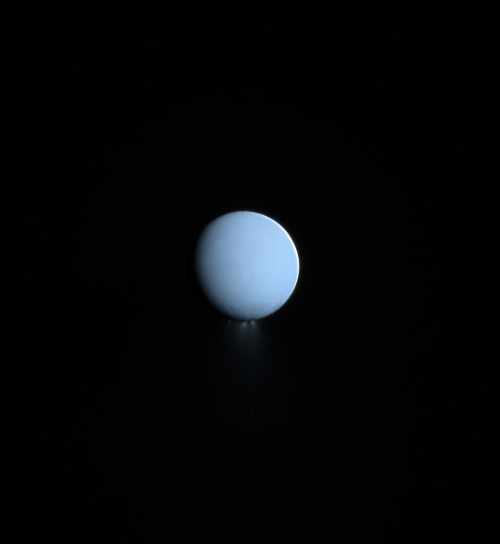



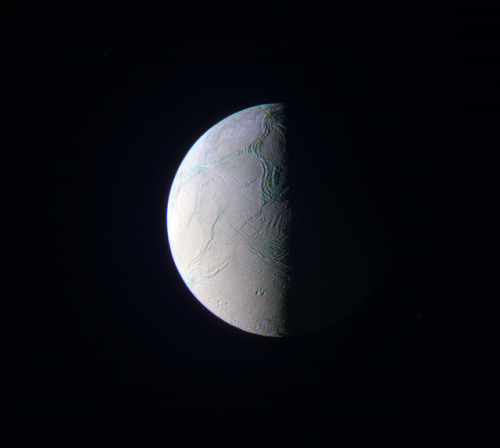

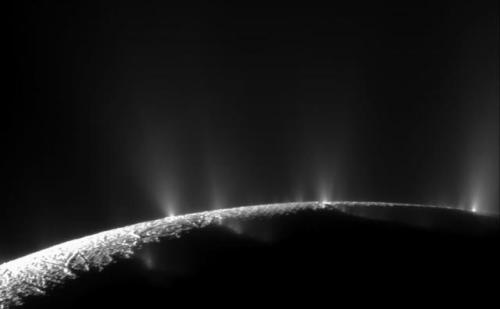

Enceladus
Enceladus is one of the major inner moons of Saturn along with Dione, Tethys, and Mimas. It orbits Saturn at a distance of 148,000 miles (238,000 km), falling between the orbits of Mimas and Tethys. It is tidally locked with Saturn, keeping the same face toward the planet. It completes one orbit every 32.9 hours within the densest part of Saturn’s E Ring, the outermost of its major rings, and is its main source.
Enceladus is, like many moons in the extensive systems of the giant planets, trapped in an orbital resonance. Its resonance with Dione excites its orbital eccentricity, which is damped by tidal forces, tidally heating its interior, and possibly driving the geological activity.
Enceladus is Saturn’s sixth largest moon, only 157 miles (252 km) in mean radius, but it’s one of the most scientifically compelling bodies in our solar system. Hydrothermal vents spew water vapor and ice particles from an underground ocean beneath the icy crust of Enceladus. This plume of material includes organic compounds, volatile gases, carbon dioxide, carbon monoxide, salts and silica.
With its global ocean, unique chemistry and internal heat, Enceladus has become a promising lead in our search for worlds where life could exist.

In 2005, Cassini’s multiple instruments discovered that this icy outpost is gushing water vapor geysers out to a distance of three times the radius of Enceladus. The icy water particles are roughly one ten-thousandth of an inch, or about the width of a human hair. The particles and gas escape the surface at jet speed at approximately 800 miles per hour (400 meters per second). The eruptions appear to be continuous, refreshing the surface and generating an enormous halo of fine ice dust around Enceladus, which supplies material to one of Saturn’s rings, the E-ring.
Several gases, including water vapor, carbon dioxide, methane, perhaps a little ammonia and either carbon monoxide or nitrogen gas make up the gaseous envelope of the plume.
Read more at: solarsystem.nasa.gov
Image credit: NASA/JPL/Cassini & Kevin Gill
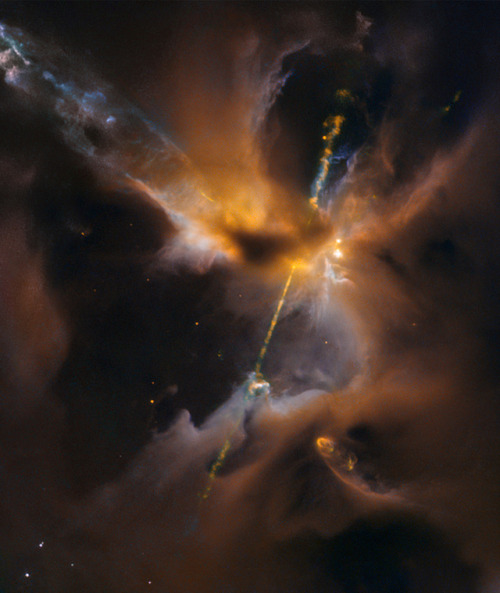
Hubble Sees the Force Awakening in a Newborn Star
This celestial lightsaber does not lie in a galaxy far, far away, but rather inside our home galaxy, the Milky Way. It’s inside a turbulent birthing ground for new stars known as the Orion B molecular cloud complex, located 1,350 light-years away.
In the center of the image, partially obscured by a dark, Jedi-like cloak of dust, a newborn star shoots twin jets out into space as a sort of birth announcement to the universe
Credit: NASA/ESA
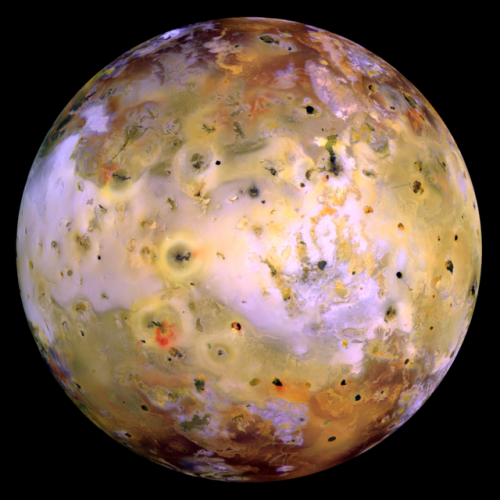
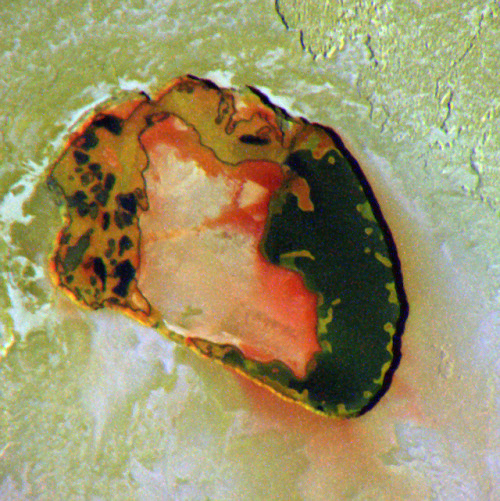
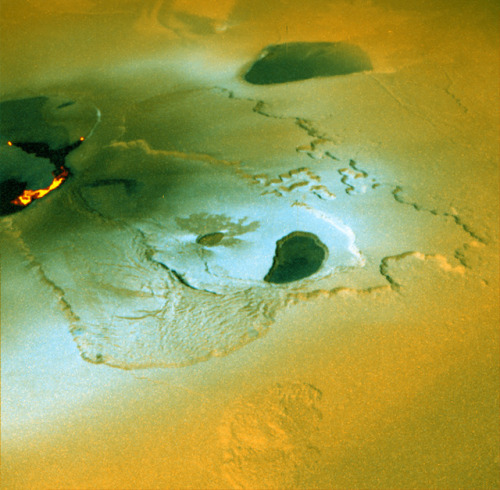
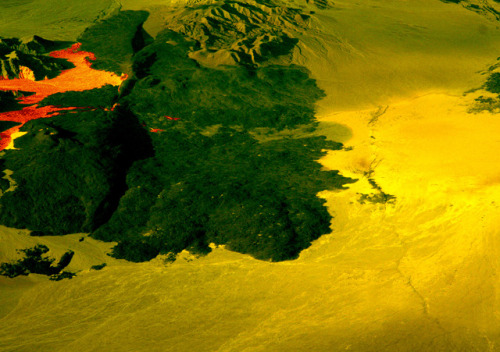
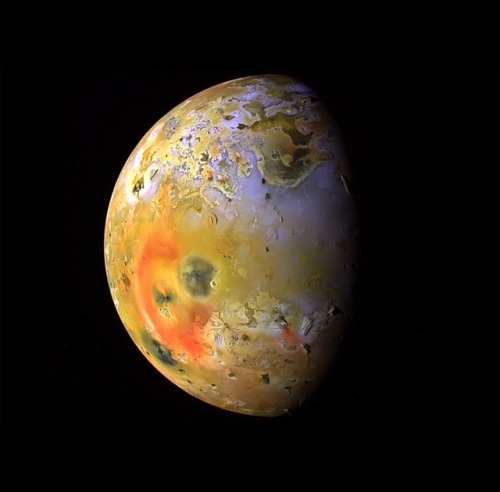
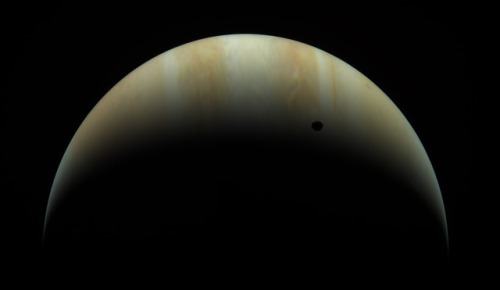
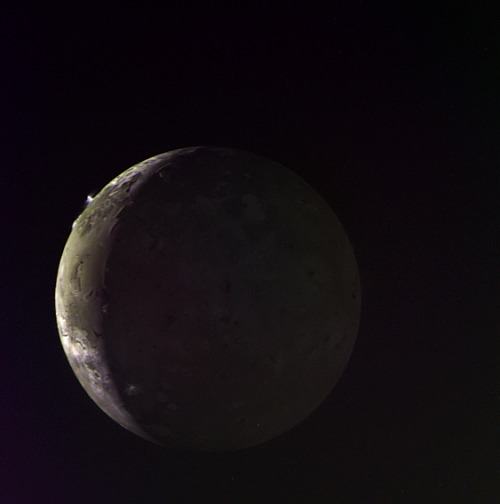
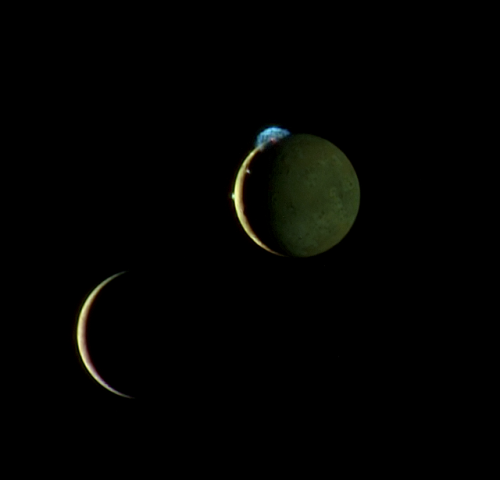
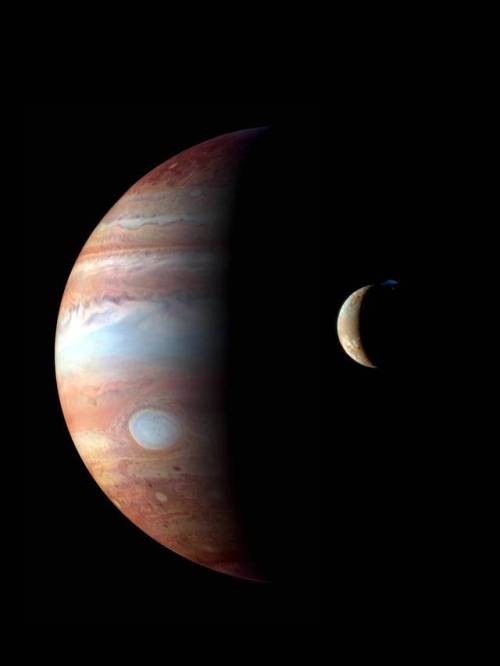
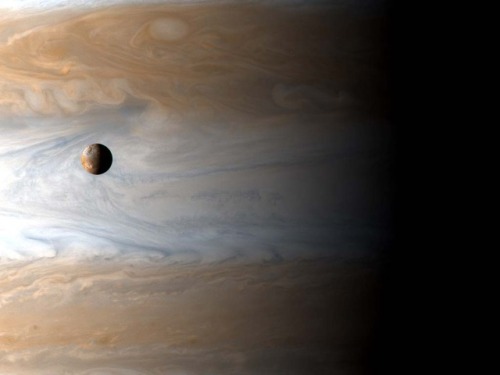
Io - The Volcanic Moon
Looking like a giant pizza covered with melted cheese and splotches of tomato and ripe olives, Io is the most volcanically active body in the solar system. Volcanic plumes rise 300 km (190 miles) above the surface, with material spewing out at nearly half the required escape velocity.
A bit larger than Earth’s Moon, Io is the third largest of Jupiter’s moons, and the fifth one in distance from the planet.
Although Io always points the same side toward Jupiter in its orbit around the giant planet, the large moons Europa and Ganymede perturb Io’s orbit into an irregularly elliptical one. Thus, in its widely varying distances from Jupiter, Io is subjected to tremendous tidal forces. These forces cause Io’s surface to bulge up and down (or in and out) by as much as 100 m (330 feet)! Compare these tides on Io’s solid surface to the tides on Earth’s oceans. On Earth, in the place where tides are highest, the difference between low and high tides is only 18 m (60 feet), and this is for water, not solid ground!
This tidal pumping generates a tremendous amount of heat within Io, keeping much of its subsurface crust in liquid form seeking any available escape route to the surface to relieve the pressure. Thus, the surface of Io is constantly renewing itself, filling in any impact craters with molten lava lakes and spreading smooth new floodplains of liquid rock. The composition of this material is not yet entirely clear, but theories suggest that it is largely molten sulfur and its compounds (which would account for the varigated coloring) or silicate rock (which would better account for the apparent temperatures, which may be too hot to be sulfur). Sulfur dioxide is the primary constituent of a thin atmosphere on Io. It has no water to speak of, unlike the other, colder Galilean moons. Data from the Galileo spacecraft indicates that an iron core may form Io’s center, thus giving Io its own magnetic field.
Io was discovered on 8 January 1610 by Galileo Galilei. The discovery, along with three other Jovian moons, was the first time a moon was discovered orbiting a planet other than Earth.

Eruption of the Tvashtar volcano on Jupiter’s moon Io, photographed by New Horizons.
Image credit: NASA/JPL/Galileo/New Horizons ( Stuart Rankin | Kevin Gill)
Source: NASA


What are Pulsars?
Pulsars are spherical, compact objects that are about the size of a large city but contain more mass than the sun. Discovered in 1967, pulsars are fascinating members of the cosmic community.
From Earth, pulsars often look like flickering stars. On and off, on and off, they seem to blink with a regular rhythm. But the light from pulsars does not actually flicker or pulse, and these objects are not actually stars.
Pulsars radiate two steady, narrow beams of light in opposite directions. Although the light from the beam is steady, pulsars appear to flicker because they also spin. It’s the same reason a lighthouse appears to blink when seen by a sailor on the ocean: As the pulsar rotates, the beam of light may sweep across the Earth, then swing out of view, then swing back around again. To an astronomer on the ground, the light goes in and out of view, giving the impression that the pulsar is blinking on and off. The reason a pulsar’s light beam spins around like a lighthouse beam is that the pulsar’s beam of light is typically not aligned with the pulsar’s axis of rotation.
Click here to see the animation
Click here to hear the pulsars sound
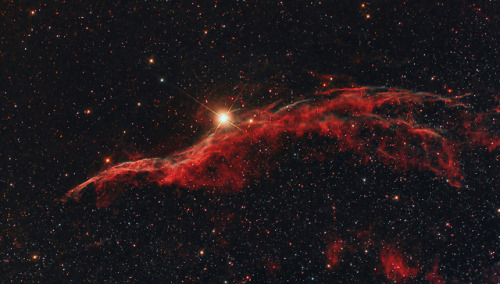
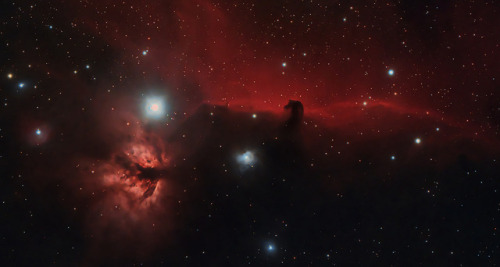
NGC 6960 (Western Veil nebula) & Horsehead Nebula and the Flame Nebula
by David Wills
-
 thnkng-srw-is-perfection liked this · 4 years ago
thnkng-srw-is-perfection liked this · 4 years ago -
 lotusofthesun liked this · 4 years ago
lotusofthesun liked this · 4 years ago -
 thomasbrisenio reblogged this · 5 years ago
thomasbrisenio reblogged this · 5 years ago -
 nicolesoldtheworld reblogged this · 5 years ago
nicolesoldtheworld reblogged this · 5 years ago -
 soapsoundz reblogged this · 5 years ago
soapsoundz reblogged this · 5 years ago -
 ulk78 liked this · 5 years ago
ulk78 liked this · 5 years ago -
 2fiona reblogged this · 5 years ago
2fiona reblogged this · 5 years ago -
 therealsirsticker liked this · 5 years ago
therealsirsticker liked this · 5 years ago -
 notisaidthechicken liked this · 5 years ago
notisaidthechicken liked this · 5 years ago -
 lunardoughnut liked this · 5 years ago
lunardoughnut liked this · 5 years ago -
 m1acp reblogged this · 5 years ago
m1acp reblogged this · 5 years ago -
 m1acp liked this · 5 years ago
m1acp liked this · 5 years ago -
 spaceghost678-blog liked this · 5 years ago
spaceghost678-blog liked this · 5 years ago -
 beardnerd liked this · 5 years ago
beardnerd liked this · 5 years ago -
 imaginesofthefandoms liked this · 5 years ago
imaginesofthefandoms liked this · 5 years ago -
 fallen549 liked this · 5 years ago
fallen549 liked this · 5 years ago -
 shtrbger liked this · 5 years ago
shtrbger liked this · 5 years ago -
 gia-is-a-punk-rocker liked this · 5 years ago
gia-is-a-punk-rocker liked this · 5 years ago -
 fortwinks5 liked this · 5 years ago
fortwinks5 liked this · 5 years ago -
 watchergnome liked this · 5 years ago
watchergnome liked this · 5 years ago -
 angelskill liked this · 5 years ago
angelskill liked this · 5 years ago -
 void-tiger reblogged this · 5 years ago
void-tiger reblogged this · 5 years ago -
 void-tiger liked this · 5 years ago
void-tiger liked this · 5 years ago -
 smallfryingpan liked this · 5 years ago
smallfryingpan liked this · 5 years ago -
 pinkabrinka liked this · 5 years ago
pinkabrinka liked this · 5 years ago -
 xavier-landrau liked this · 5 years ago
xavier-landrau liked this · 5 years ago -
 insidiousclouds-2 liked this · 5 years ago
insidiousclouds-2 liked this · 5 years ago -
 yikes-morgs liked this · 5 years ago
yikes-morgs liked this · 5 years ago -
 cumberbees reblogged this · 5 years ago
cumberbees reblogged this · 5 years ago -
 cumberbees liked this · 5 years ago
cumberbees liked this · 5 years ago -
 giraffealo liked this · 5 years ago
giraffealo liked this · 5 years ago -
 metalzoic liked this · 5 years ago
metalzoic liked this · 5 years ago -
 xxfr0stb1tt3n-cl0v3rsxx liked this · 5 years ago
xxfr0stb1tt3n-cl0v3rsxx liked this · 5 years ago -
 wisent15 reblogged this · 5 years ago
wisent15 reblogged this · 5 years ago -
 wisent15 liked this · 5 years ago
wisent15 liked this · 5 years ago -
 anonymous-buddy69 reblogged this · 5 years ago
anonymous-buddy69 reblogged this · 5 years ago -
 anonymous-buddy69 liked this · 5 years ago
anonymous-buddy69 liked this · 5 years ago -
 xavier-landrau reblogged this · 5 years ago
xavier-landrau reblogged this · 5 years ago -
 faintrecognition liked this · 5 years ago
faintrecognition liked this · 5 years ago -
 themosthairiestlobsterintheworld liked this · 5 years ago
themosthairiestlobsterintheworld liked this · 5 years ago -
 sodom-and-garfunkle reblogged this · 6 years ago
sodom-and-garfunkle reblogged this · 6 years ago -
 tropicats reblogged this · 6 years ago
tropicats reblogged this · 6 years ago -
 16fahri liked this · 6 years ago
16fahri liked this · 6 years ago -
 fangirlsencyclopaediaofweirdness liked this · 6 years ago
fangirlsencyclopaediaofweirdness liked this · 6 years ago -
 cloudninebts reblogged this · 6 years ago
cloudninebts reblogged this · 6 years ago
For more content, Click Here and experience this XYHor in its entirety!Space...the Final Frontier. Let's boldly go where few have gone before with XYHor: Space: Astronomy & Spacefaring: the collection of the latest finds and science behind exploring our solar system, how we'll get there and what we need to be prepared for!
128 posts